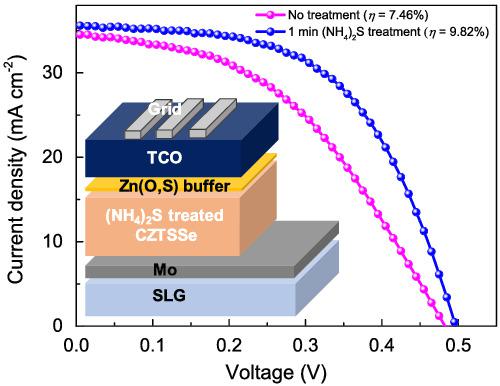当前位置:
X-MOL 学术
›
Prog. Photovoltaics
›
论文详情
Our official English website, www.x-mol.net, welcomes your
feedback! (Note: you will need to create a separate account there.)
CZTSSe/Zn(O,S) heterojunction solar cells with 9.82% efficiency enabled via (NH4)2S treatment of absorber layer
Progress in Photovoltaics ( IF 8.0 ) Pub Date : 2021-05-25 , DOI: 10.1002/pip.3439 Hiji Jeong 1 , Raju Nandi 1 , Jae Yu Cho 1 , Pravin S. Pawar 1 , Hyo Seok Lee 1 , KrishnaRao Eswar Neerugatti 1 , Jin Hyeok Kim 1 , Jaeyeong Heo 1
Progress in Photovoltaics ( IF 8.0 ) Pub Date : 2021-05-25 , DOI: 10.1002/pip.3439 Hiji Jeong 1 , Raju Nandi 1 , Jae Yu Cho 1 , Pravin S. Pawar 1 , Hyo Seok Lee 1 , KrishnaRao Eswar Neerugatti 1 , Jin Hyeok Kim 1 , Jaeyeong Heo 1
Affiliation

|
The replacement of CdS buffer layer is desirable for the development of nontoxic, environmentally friendly kesterite thin-film solar cells (TFSCs). Recently, several ternary compound semiconductors have been extensively investigated as an alternative buffer layer for Cd-free TFSCs. Herein, the effectiveness of (NH4)2S treatment on the surface properties of the absorber, as well as the device performance of atomic layer deposited (ALD) Zn(O,S) buffer-based CZTSSe solar cells, has been investigated. X-ray photoelectron spectroscopy (XPS) results showed that the elemental compositions of CZTSSe surface were significantly influenced by (NH4)2S treatment, whereas the surface morphologies of the CZTSSe-absorber layers remained unaffected. The XPS results further suggested that the (NH4)2S solution treatment substantially removed the native oxide layer from the CTZSSe absorber surface. The fabricated CZTSSe/Zn(O,S) device without (NH4)2S treatment displayed an initial cell efficiency of 7.46%. The energy conversion efficiency increased significantly to 9.82% after the (NH4)2S treatment of absorber layers for an optimum duration of 1 min; to the best of our knowledge, this is the highest efficiency achieved to date for Zn(O,S) buffer-based kesterite solar cells. The improved device performance is predominantly attributed to the pronounced increase in the fill factor (FF) of TFSCs resulting from the removal of oxides/hydroxides from the CZTSSe surface and passivation of absorber surface with sulfur species. However, increasing the treatment duration to 3 or 5 min resulted in the deterioration of cell efficiency, primarily due to the progressive degradation in the FF of the device. This study demonstrates a plausible route to improve the performance of Zn(O,S) buffer layer-based kesterite solar cells through a simple surface treatment of the absorber layers using (NH4)2S solution.
中文翻译:

CZTSSe/Zn(O,S) 异质结太阳能电池通过 (NH4)2S 处理吸收层实现了 9.82% 的效率
更换 CdS 缓冲层对于开发无毒、环保的锌黄锡矿薄膜太阳能电池 (TFSC) 是可取的。最近,已经广泛研究了几种三元化合物半导体作为无 Cd TFSC 的替代缓冲层。在此,研究了 (NH 4 ) 2 S 处理对吸收体表面性质的有效性,以及基于原子层沉积 (ALD) Zn(O,S) 缓冲液的 CZTSSe 太阳能电池的器件性能。X射线光电子能谱(XPS)结果表明(NH 4 ) 2显着影响CZTSSe表面的元素组成S 处理,而 CZTSSe 吸收层的表面形态不受影响。XPS 结果进一步表明,(NH 4 ) 2 S 溶液处理基本上从 CTZSSe 吸收体表面去除了天然氧化物层。未经 (NH 4 ) 2 S 处理的制造的 CZTSSe/Zn(O,S) 器件显示出 7.46% 的初始电池效率。(NH 4 ) 2后能量转换效率显着提高至9.82%对吸收层进行 S 处理,最佳持续时间为 1 分钟;据我们所知,这是迄今为止基于 Zn(O,S) 缓冲液的锌黄锡矿太阳能电池实现的最高效率。改进的器件性能主要归因于从 CZTSSe 表面去除氧化物/氢氧化物和用硫物质钝化吸收器表面导致 TFSC 填充因子 (FF) 的显着增加。然而,将处理持续时间增加到 3 或 5 分钟会导致电池效率下降,这主要是由于设备的 FF 逐渐退化。本研究展示了一种通过使用 (NH 4 ) 2对吸收层进行简单表面处理来提高基于 Zn(O,S) 缓冲层的锌黄锡矿太阳能电池性能的可行途径S 解决方案。
更新日期:2021-05-25
中文翻译:

CZTSSe/Zn(O,S) 异质结太阳能电池通过 (NH4)2S 处理吸收层实现了 9.82% 的效率
更换 CdS 缓冲层对于开发无毒、环保的锌黄锡矿薄膜太阳能电池 (TFSC) 是可取的。最近,已经广泛研究了几种三元化合物半导体作为无 Cd TFSC 的替代缓冲层。在此,研究了 (NH 4 ) 2 S 处理对吸收体表面性质的有效性,以及基于原子层沉积 (ALD) Zn(O,S) 缓冲液的 CZTSSe 太阳能电池的器件性能。X射线光电子能谱(XPS)结果表明(NH 4 ) 2显着影响CZTSSe表面的元素组成S 处理,而 CZTSSe 吸收层的表面形态不受影响。XPS 结果进一步表明,(NH 4 ) 2 S 溶液处理基本上从 CTZSSe 吸收体表面去除了天然氧化物层。未经 (NH 4 ) 2 S 处理的制造的 CZTSSe/Zn(O,S) 器件显示出 7.46% 的初始电池效率。(NH 4 ) 2后能量转换效率显着提高至9.82%对吸收层进行 S 处理,最佳持续时间为 1 分钟;据我们所知,这是迄今为止基于 Zn(O,S) 缓冲液的锌黄锡矿太阳能电池实现的最高效率。改进的器件性能主要归因于从 CZTSSe 表面去除氧化物/氢氧化物和用硫物质钝化吸收器表面导致 TFSC 填充因子 (FF) 的显着增加。然而,将处理持续时间增加到 3 或 5 分钟会导致电池效率下降,这主要是由于设备的 FF 逐渐退化。本研究展示了一种通过使用 (NH 4 ) 2对吸收层进行简单表面处理来提高基于 Zn(O,S) 缓冲层的锌黄锡矿太阳能电池性能的可行途径S 解决方案。











































 京公网安备 11010802027423号
京公网安备 11010802027423号